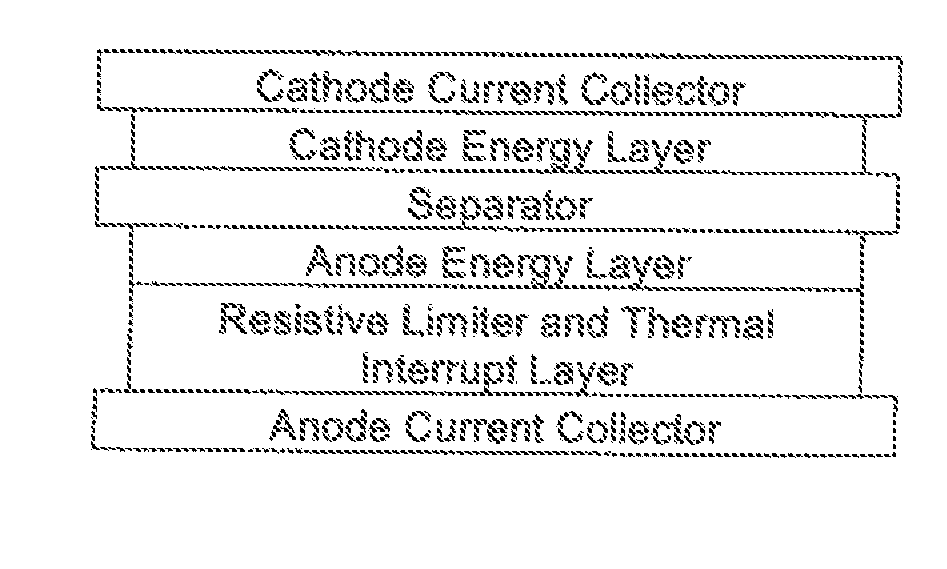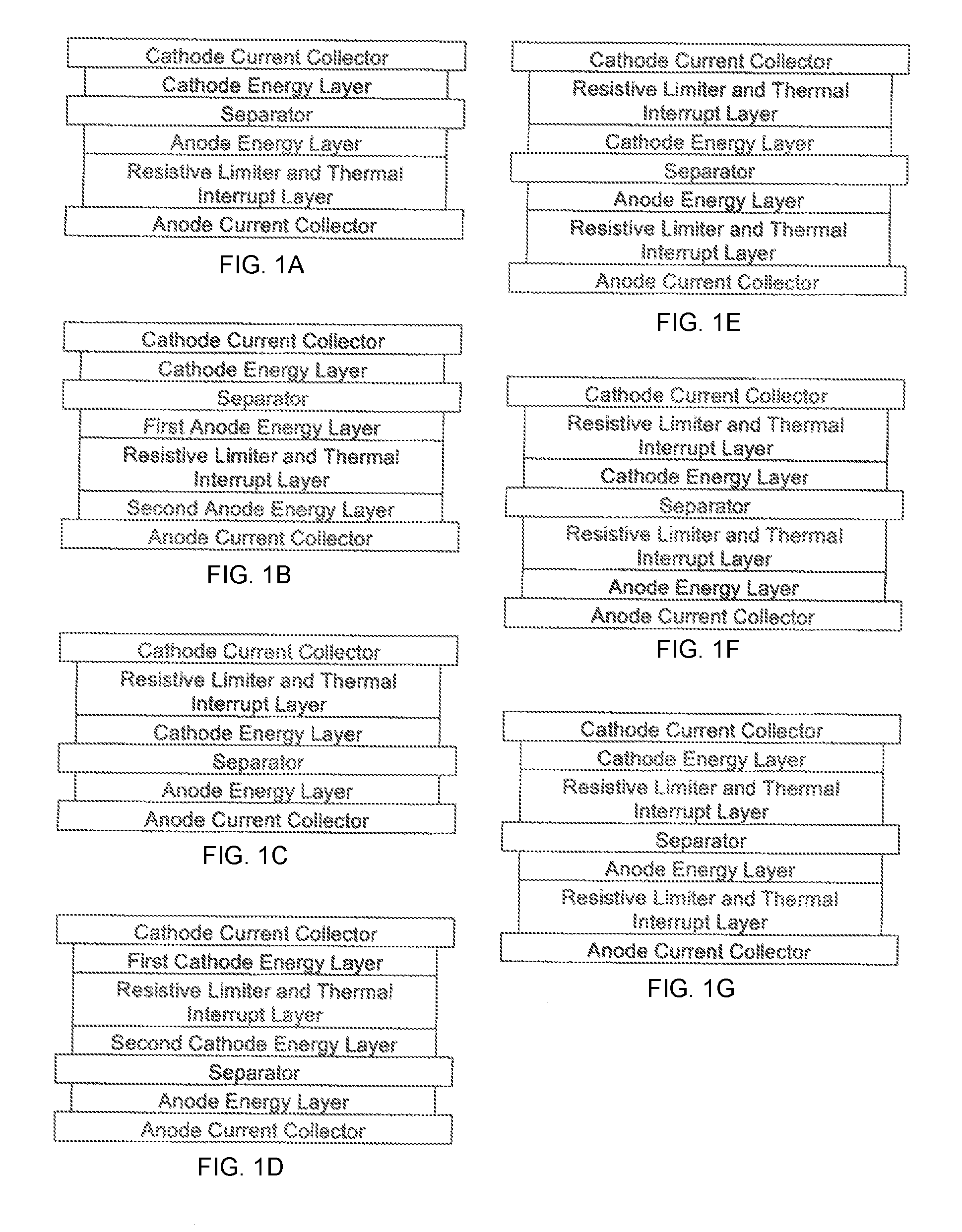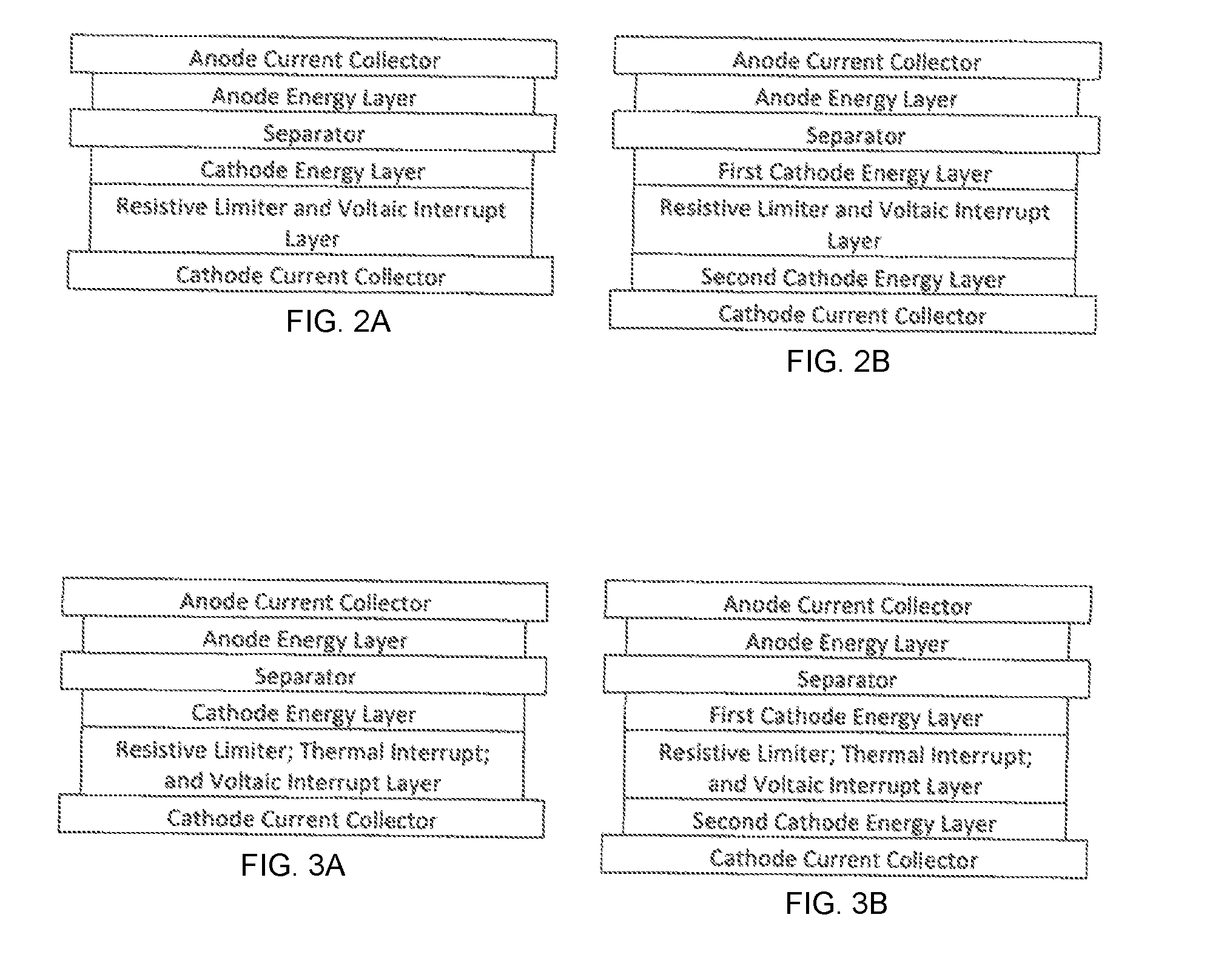Rechargeable battery with internal current limiter and interrupter
a rechargeable battery and current interrupter technology, applied in the direction of batteries, cell components, safety/protection circuits, etc., can solve the problems of two electrodes, a risk of short circuit, and a risk of overcharging, so as to achieve safe charging voltage, high energy density, and safe operating temperature range
- Summary
- Abstract
- Description
- Claims
- Application Information
AI Technical Summary
Benefits of technology
Problems solved by technology
Method used
Image
Examples
example 1
Preparation of Baseline Electrodes, Positive and Negative Electrodes, and the Completed Cell #1 for the Evaluation in the Resistance Measurement, Discharge Capability Tests at 50° C., Impact Test, and Cycle Life Test
[0246]A) Preparation of POS1 A as an Example of the Positive Electrode Preparation.
[0247]i) Dissolve PVDF (21.6 g) into NMP (250 g); ii) Add carbon black (18 g) and mix for 15 minutes at 6500 rpm; iii) Add LiNi0.5Mn0.3CO0.2O2 (NMC) (560.4 g) to the slurry from Step ii and mix for 30 minutes at 6500 rpm to form a flowable slurry; iv) Some NMP may be added for the viscosity adjustment; v) Coat this slurry onto 15 □ Coat this slurry onto 15 the viscosity adjustment; e slurry; pability tests at 50eted Cell ° C. and the second heat zone to about 130° C. to evaporate off the NMP. The final dried solid loading is about 15.55 mg / cm2. The positive layer was then compressed to a thickness of about 117 μm. The electrode made here is called as zero voltage against graphite electrode...
example 2
Preparation of CaCO3 Based Gas Generator and Resistive Layer, Positive and Negative Electrodes, and the Completed Cell #3 for the Evaluation in the Resistance Measurement, Discharge Capability Tests at 50° C., Impact Test, Over Charge, and Cycle Life Test
[0253]A) Positive POS3B as an Example of a Gas Generator and Resistive Layer (1st Layer) Preparation.
[0254]i) Dissolve Torlon®4000TF (0.8 g) into NMP (10 g); ii) Dissolve PVDF (4.8 g) into NMP (˜70 g); iii) Mix solution prepared in Step i and ii, and then add carbon black (0.32 g) and mix for 10 minutes at 6500 rpm; iv) Add nano CaCO3 powder (34.08 g) to the solution from Step iii and mix for 20 minutes at 6500 rpm to form a flowable slurry; v) Coat this slurry onto 15□ Coat this slurry onto 15 6500 rpm to form a flowable slurry; 6500 rpm; sts at 50 completed Cell #° C. and the second heat zone to about 165° C. to evaporate off the NMP. The final dried solid loading is about 1 mg / cm2.
[0255]B) Preparation of POS3 A as an Example of t...
example 3
[0262]Preparation of 50% Al2O3 and 50% CaCO3 based gas generator and resistive layer, positive and negative electrodes, and the completed Cell #4 for the evaluation in the resistance measurement, discharge capability tests at 50° C., impact test, over charge and cycle life tests:
[0263]A) Positive POS4B as an Example of a Gas Generator and Resistive Layer (1st Layer) Preparation.
[0264]i) Dissolve Torlon®4000TF (0.8 g) into NMP (10 g); ii) Dissolve PVDF (4.8 g) into NMP (˜70 g); iii) Mix solution prepared in Step i and ii, and then add carbon black (0.32 g) and mix for 10 minutes at 6500 rpm; iv) Add nano CaCO3 powder (17.04 g) and Al2O3 powder (17.04 g) to the solution from Step iii and mix for 20 minutes at 6500 rpm to form a flowable slurry; v) Coat this slurry onto 15□ Coat this slurry onto 15 6500 rpm to form a flowable slurry; 6500 rpm; sts at 50 completed Cell #° C. and the second heat zone to about 165° C. to evaporate off the NMP. The final dried solid loading is about 1 mg / c...
PUM
| Property | Measurement | Unit |
|---|---|---|
| energy density | aaaaa | aaaaa |
| resistivity | aaaaa | aaaaa |
| charging voltage | aaaaa | aaaaa |
Abstract
Description
Claims
Application Information
 Login to View More
Login to View More - R&D
- Intellectual Property
- Life Sciences
- Materials
- Tech Scout
- Unparalleled Data Quality
- Higher Quality Content
- 60% Fewer Hallucinations
Browse by: Latest US Patents, China's latest patents, Technical Efficacy Thesaurus, Application Domain, Technology Topic, Popular Technical Reports.
© 2025 PatSnap. All rights reserved.Legal|Privacy policy|Modern Slavery Act Transparency Statement|Sitemap|About US| Contact US: help@patsnap.com



